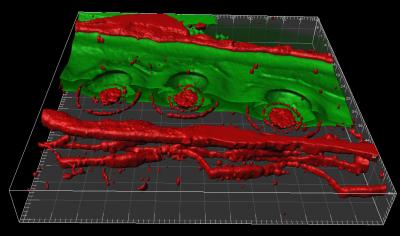Why don’t trees “bleed” to death when they are injured?
Researchers from Virginia Tech, the Georg-August University of Gottingen, Germany, and the Jackson Laboratory of Bar Harbor, Maine, have discovered how “check valves” in wood cells control sap flow and protect trees when they are injured.
The study, featured on the cover of the September issue of the American Journal of Botany, used a special microscope to reveal how nanostructures help contain damage within microscopic cavities called bordered pits in wood-fiber cells. The pits allow sap to circulate through adjacent cells.
Previously, wood had to be dried, coated with carbon, and put under a high vacuum to be studied at the nanolevel. But using a powerful new type of confocal, laser-scanning microscope, the 4Pi, the scientists discovered that the bordered pits are filled with a mesh membrane of nanofibrils, which radiate from a thickened, solid central region called the torus — like a bull’s-eye in a target.
Fluids ooze in, through the mesh-like membrane, around the torus, and out the other side.
“When wood is injured, such as by an insect, or is being dried, like we do with kiln-dried lumber, the torus and part of the membrane will typically shift from the center of the pit to one side to seal the pit opening,” said Barry Goodell, a professor of sustainable biomaterials in the College of Natural Resources and Environment at Virginia Tech. “When we used specific chemical tags to dye the pectin red and cellulose green, we saw for the first time that pectin surrounds the torus and forms ring-like structures at the margin of the torus. Scientists had never seen these before, nor knew there is pectin in these unique ring-like structures in the membrane. As part of the pit-sealing process, pectin separates to form an outer fringe around the torus, while the bulk of the pectin gets pulled into the aperture to block it.
“It helps explain how trees seal off the cells of wood so that softwood trees don’t ‘bleed to death,’ or lose all their sap when they are injured,” Goodell said. “Without pectin, a tree cannot defend itself, and it can’t seal off damaged cells.”
The American Journal of Botany is one of the 10 most influential journals over the last 100 years in the field of biology and medicine, according to the BioMedical & Life Sciences Division of the Special Libraries Association.
The study was written by Daniela Maschek, a student at Georg-August University of Gottingen, who worked in Goodell’s lab. Additional collaborators include Jody Jellison, a professor of plant pathology and associate director of the Virginia Agricultural Experiment Station; Mark Lessard of the Jackson Laboratory, and Holger Militz, a professor at Georg-August University of Gottingen.
The reason the pit membrane seals the cell is explained by simple physics, Goodell said.
“When the tree is injured, sap starts to flow out, and air flows in. This changes the partial pressure and, just like a check valve used in plumbing systems, the bordered pit closes,” Goodell said. “The movement and redistribution of the pectin is also in response to this partial pressure differential. Similarly, when water flows within the cells, then pectin in specific locations in the cell wall will swell and form a gel. When it swells, it reduces the size of the pores in the border pit, and that will reduce water flow.”
The researchers speculate that the ring of pectin around the torus functions as a buffer to help relieve mechanical stress during the deformation of the pit membrane, “thus preventing the stiffer cellulose strands from detaching from the cell wall, or breaking in that area.”
The bordered pit system has many functions. In the living tree, it allows sap to flow up the tree while also helping to prevent embolisms — the spread of air pockets in the tree. In wood fallen to the forest floor, it controls the rate that fungi advance through the wood cells to cause decay and ultimately the rate at which carbon is cycled as it is returned to the atmosphere.
In wood products, the sealed wood fiber cells are what make some wood species so difficult to dry; which is the most expensive part of wood processing. It can also make wood treatment and fractionation difficult — the first step in extracting natural chemicals from wood to make products ranging from medicinal polymers to sugars that are the basis for bioenergy systems.
In addition to his work on the bordered pits in wood, Goodell works in the area of advanced engineered composites fabrication, and in biomass bioconversion. He is also a leading authority on the biochemistry of “brown rot” wood-decay fungi, which nature uses to breakdown the cell walls of wood fiber, and which some day may be used in biomass conversion processes for energy and sustainable biomaterials production. His study of the brown rot fungi led him to study tree defenses at the nanostructure scale.


